Restaurant and Bar Owners in Istria and Kvarner Call for Aid to Survive
ZAGREB, September 10, 2020 - Over 600 restaurant and bar owners in Kvarner and Istria today closed their facilities for an hour, starting from 11.55 am, to warn about the difficulties they are facing due to epidemiological restrictions and to ask for assistance in order to survive until the next season.
The association of Kvarner and Istria restaurant and cafe owners, which initiated the campaign held under the slogan "Let us close today to stay open tomorrow", said that the campaign was successful. The goal was to encourage responsible institutions to urgently take action to preserve jobs in the sector and prevent its collapse.
The head of the above-mentioned association and the deputy head of the national association of restaurant and cafe owners, Vedran Jakominic, said that stakeholders in the hospitality sector were calling for a preferential VAT rate on food and beverages. He also said that they were having difficulties in obtaining loans and that it was necessary to provide stakeholders in the hospitality sector with access to liquidity loans.
"Let us work, pay employees, rents, fees and taxes because s scorched earth can bear no fruit. We believe that you are doing what you think is right, but let the profession tell you that you have made a mistake," Jakominic said.
He pointed out that job-retention measures had saved workers in restaurants and cafes from lay-offs but that they had not saved entrepreneurs.
He said that a survey had shown that 60% of stakeholders in the hospitality sector had seen a drop in business of over 50% and 40% estimated that they would not survive until the next season in the current conditions. About 80% will have to cancel employment contracts, said Jakominic, who noted that there could be about 20,000 lay-offs in the hospitality sector.
For the latest travel info, bookmark our main travel info article, which is updated daily.
Read the Croatian Travel Update in your language - now available in 24 languages
International Cuisine In Zagreb: Khaos Thai
August 6, 2020 - Continuing our series on Zagreb’s international food offer and the stories behind these cuisines and businesses. This time, the spicy but light takeaway lunches of Khaos Thai.
Rinrampai Lateja and Saralee Madnui standing outside the Khaos Thai kiosk, next to Importanne Gallery on Vlaška ulica © Mateo Henec
Saralee Madnui: We’re both from Thailand. I’m from the south of Thailand, close to the border with Malaysia.
Rinrampai Lateja: I’m from Bangkok, the capital city. It’s in the centre.
Saralee: I’ve been here for five years, her for ten. We’re both here for the same reason; we’re married to Croatians. I met my husband when he was visiting Thailand. She met her’s while she was working on a cruise ship.
Saralee: Every region of Thailand has a different taste. In the north, the food is a little bit soft, but still spicy from curry paste. In the northeast, their flavours are really strong, spicy and sour, but they use much less fat. The land in that region is not so rich and the food is fast and simple, cooked quickly on the grill or in a pan. In the south, where I’m from, we have all the food; coconut, fish from the sea. The climate is good and anything can grow there. It’s a very rich cuisine. In central Thailand, the taste is more smooth, but flavoursome from strong seasoning.
Khaos Thai © Mateo Henec
Saralee: The food at Khaos Thai is more like central Thai cuisine. We make some of the most well-known dishes from Thailand. Although, we also make Larb, which is from the northeast. It’s meat, fresh herbs, chilli, lime juice and rice. Salad is one of our most popular dishes here. Ours is salty, sour, crunchy and spicy, with dried shrimps, peanuts, green papaya, long beans, red tomato and chilli. It’s a very colourful dish. This is very typical of Thai cuisine; lots of different textures, flavours and colours. Like with Thai curry – the meat is cooked until it is soft, but we also add bamboo, for texture. The dish from this region that most reminds me of Thai food is goulash. It’s not the same, but it looks very similar to Massaman curry; red and with oil floating on the top. Goulash is spicy from paprika, whereas Massaman is spicy from herbs, a little more sour and it also has coconut.
Saralee: The first food that impressed me when I came to Croatia was cevapi. But, now I like more sarma. It has that sour taste that Thai people like, from the pickled cabbage. I also like it made with the green leaf (blitva). Interesting.
Saralee: When we are not working, we both very much like cycling. Cycling changed our lives.
Rinrampai: You cannot cycle in Bangkok. You would probably die. There’s so much traffic. And people just drive how they want. Never mind the rules. But, here it’s so easy to use a bicycle. You can get anywhere in Zagreb in 5 or 10 minutes on a bicycle. In Thailand, you must use a motorbike or a car.
Saralee: We love our bicycles here. We travel to work every day on bicycles. When we’re not at work we’re always riding our bicycles. I ride with my husband. I’ve ridden to Velika Gorica, Rakitje, Samobor and all over Zagreb.
TCN: You went all the way to Samobor on a bicycle?
Saralee: Yes. With my poor husband. But, he knows the tricks. He said “OK, we go Samobor for kremnšita. Then I will have power for the journey.” Ha! He was the same when we went to Velika Gorica. When we arrived, he said, “Ooh, do you remember that restaurant that is here..?"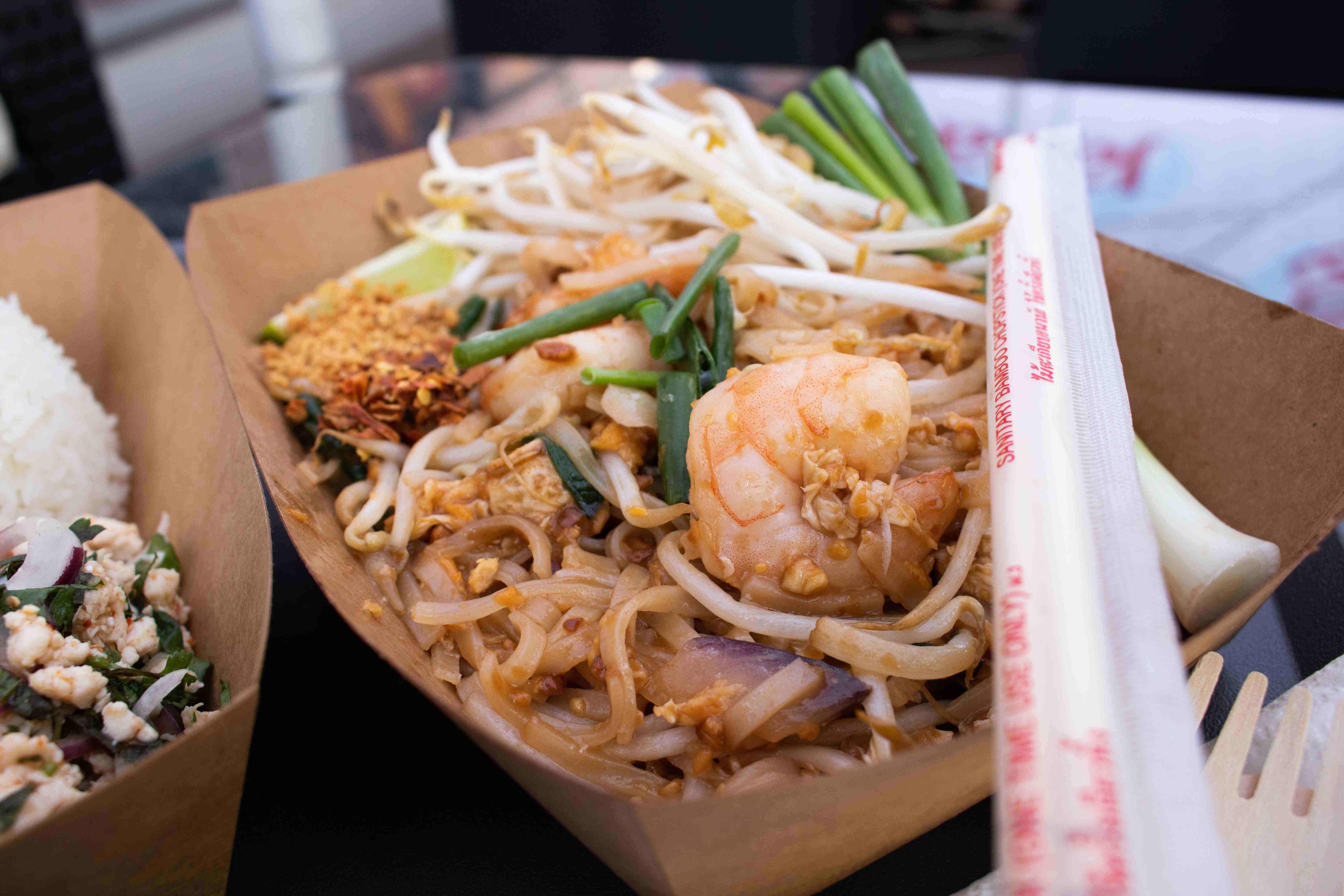
Pad Thai, one of Thailand's most famous dishes © Mateo Henec
Saralee: The dish people come back the most for here is Pad Thai. When we first opened, I thought maybe this might be too sweet for them. But, they really like it. They like the Thai Green Curry too. Some of our customers have been to Bangkok or other places in Thailand and they like to come here because our food reminds them of their visit. People tend to get the curry if they think Pad Thai is too soft for them in spiciness, or too light.
In the first week we worked, we opened at 12 midday until 8pm. There were queues around the corner. We couldn’t finish before 9pm. It was too much. There’s only the two of us. Nobody else can make this food. So, we had to reduce the hours. Now, we only work in the afternoons; midday until 5pm. But, that works very well.
Thai food is perfect for lunch; it’s all in one dish, you can hold it in your hands, it’s quite light food. The chilli and spice wakes you up and the lime and the herbs refresh you, so you are ready for the afternoon at work. It’s particularly good food for the summer.
Larb, a salad full of flavour from northeast Thailand and Pad Thai © Mateo Henec
Rinrampai: Life in Croatia is much easier than it is in Thailand. Less people, less traffic, it’s smaller, you can go anywhere. In Bangkok, if you have an appointment at 1pm, you must leave your house at 11am, sometimes earlier. The whole city is a traffic jam all day.
Saralee: Thai people and Croatian people are very similar in being very helpful, particularly to strangers. Any questions I had when I arrived, people were always happy to answer. Croatians are also a lot more friendly than other Europeans, in my experience. They are very open people. This is like Thai people too. Although Croatians follow the rules better than Thai people. Thai people ignore them all.
You can visit the Khaos Thai kiosk outside Importanne Gallery, at Trg Drage Iblera 10, on the corner of Vlaška ulica.
You can read the introduction to our series on Zagreb international cuisine and the first installment here
To follow our whole series on international cuisine and to follow the Croatian restaurant and gastro scene, keep an eye on our Gourmet pages here
International Cuisine In Zagreb: La Turka
August 4, 2020- Continuing our series on Zagreb’s international food offer and the stories behind these cuisines and businesses. This time, the authentic Istanbul experience of La Turka.
My name is Tayfun Azakli. I lived in Istanbul all my life. My mother’s family is from the part of Turkey near the Greek border, but my father’s family all come from the other side, near the border with Jordan. The western side is very close to the Balkan region in terms of food and culture. They like meat and vegetable dishes. On the Black Sea side, near Jordan, the diet is much more based on fish. The climate is also very different. It’s sub-Tropical there. They have tea fields. My grandparents were tea farmers. My mother’s parents were also farmers, but in their more European climate, they grew wheat, sunflowers, like here. They also speak different languages. On the Black Sea side, the people are not ethnically Turkish. They are Laz.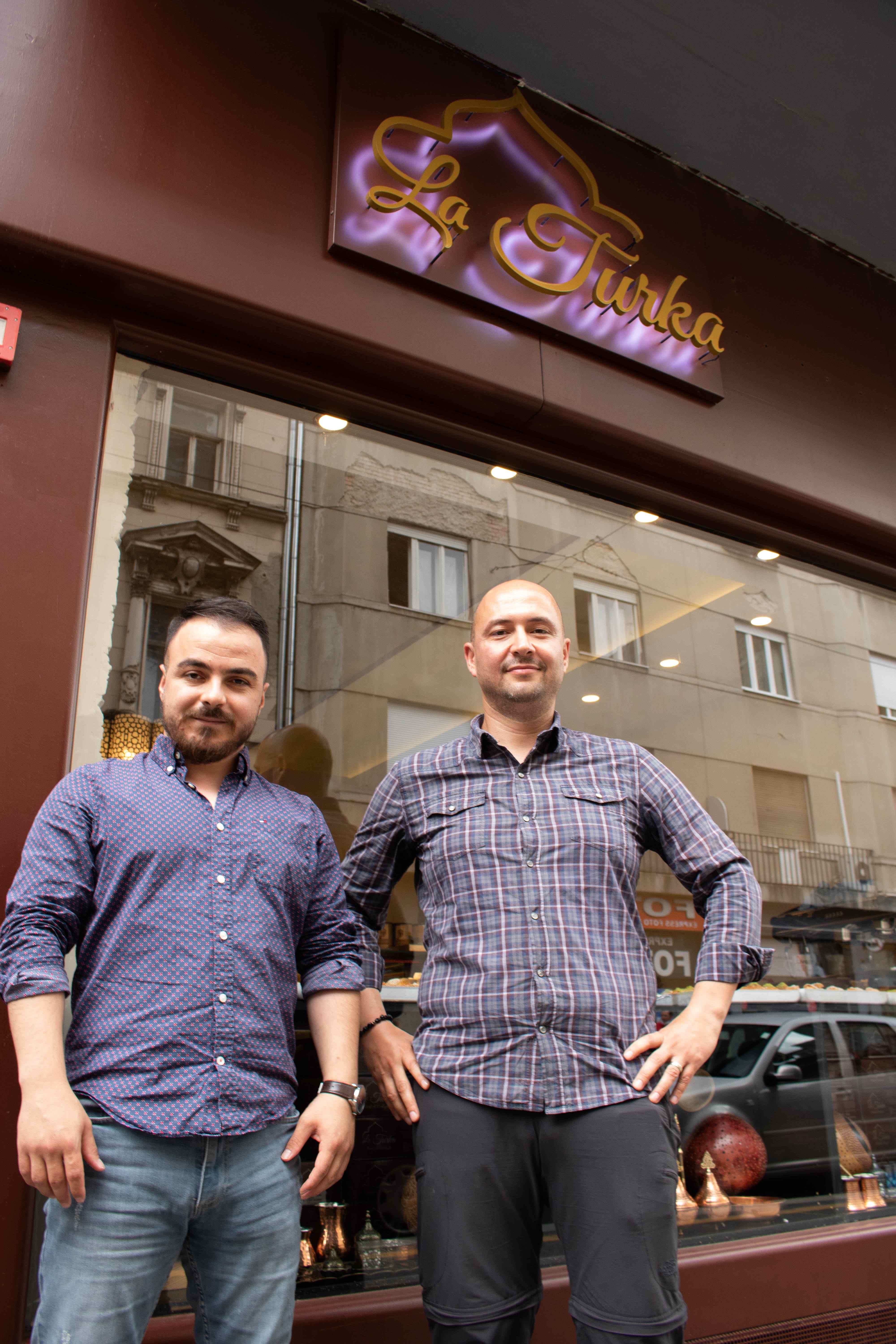
La Turka's retail manager Fares Hadad and co-founder Tayfun Azakli © Mateo Henec
I lived in Slovakia for two and a half years before coming here. I worked for Cisco Systems for 15 years – it’s one of the top 5 IT companies - and that’s where the job took me. My wife is Croatian and we decided to relocate here. We lived here for two and a half years initially, then we went to Dubai for six or seven years before coming back here two years ago.
I have two sons. I didn’t want them to grow up in Dubai. Dubai is very nice, but there’s a certain life standard. I think that if you get used to that lifestyle, you couldn’t be happy anywhere else. It’s very high end. Almost every house has a maid or nanny. Your income is three to four times what you would get in Europe. This is a huge contrast to my childhood. My mom was a teacher, my dad a civil servant. We had a limited income. Challenges to finish the month. I would work in the fields when I stayed with my grandparents. My kids were growing with a completely different perception of life in Dubai. I don’t expect them to have the same experience as me. Times have changed. But, I don’t want them to be handed everything on a plate.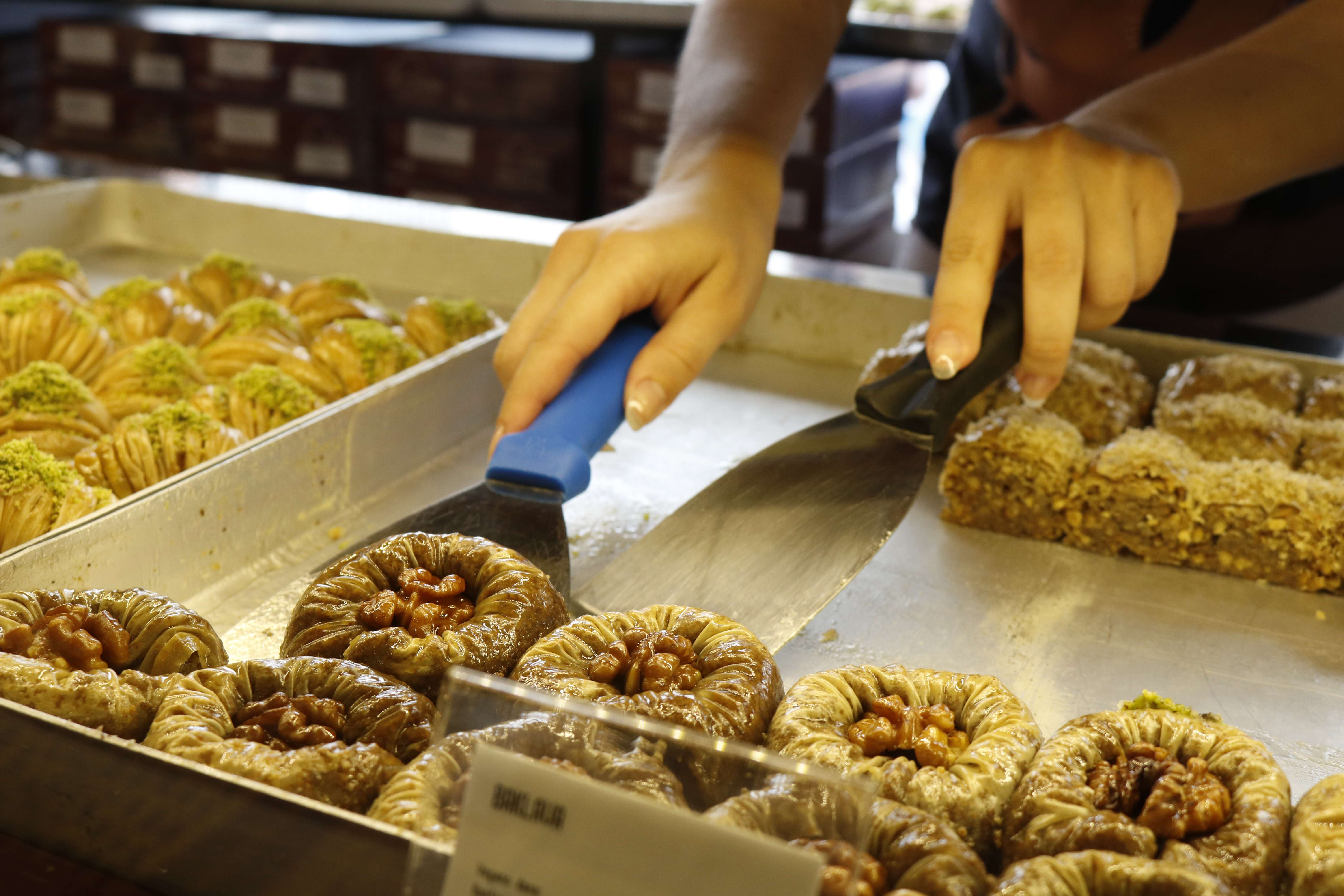
La Turka © Mateo Henec
Zagreb is a very safe and calm place to live. There is no rush in the day. The pace is quite slow. It can take some getting used to. People are nice. In any big city – be it Istanbul or London - people can be rushing and also quite rude. That doesn’t happen here. There are a lot of opportunities for businessmen here. It’s a good combination, a good place to invest. For me, at least.
In 2012 I met my business partner, Vedi Zarifgil, here in Croatia. He’s also Turkish and married to a Croatian. We started the company the next year. Originally, we were focussed only on wholesale and export. Only last year we decided to go into retail. We partnered with our friend, Fares Hadad, to open this store. It’s gone well. We plan to open two more in Zagreb during the next six months.
Ten years ago in Zagreb, there were only a few Chinese restaurants and a couple of bad Mexican places. Now, it’s very vibrant. The product that we sell is not foreign to people here, but they usually only know the Bosnian version. This is the Turkish version.
La Turka © Mateo Henec
We’re very careful about the quality of our product. For a niche product like this, I believe that you must present it at a very high quality. Then, it will sell. We didn’t expect to be so much of a hit, but we were successful from day one.
The main product we sell is baklava. The Bosnian version is made with walnuts. That’s what grows there. Ours has more finesse. In comparison, we make ours with extremely thin layers of pastry and the main nut we use is pistachio. In Bosnia, they tend to use a lot of syrup. Ours is drier. The syrup must not overpower the flavour of the pastry, the nuts, and the ghee (clarified butter). It’s a very fine balance. You should be able to taste each ingredient.
A selection of halva at La Turka © Mateo Henec
We import our pistachios from southern Turkey. Ghee is quite expensive; it’s rarely used in Bosnian baklava. Certainly not commercially. We have around 30 different variations of baklava on sale. We use almonds, pistachios, walnuts, cashew. For each of those varieties, we also have chocolate versions. For the classic baklava, the amount of nut is set, and it is ground. For alternative versions, we use whole pieces, sometimes with cream.
The presentation is key. It must look good. Classy. We want people to stop and look. We chose this street to open our business because everyone ends up here at some point. All visitors come to register at MUP. Our main client base walks here every day.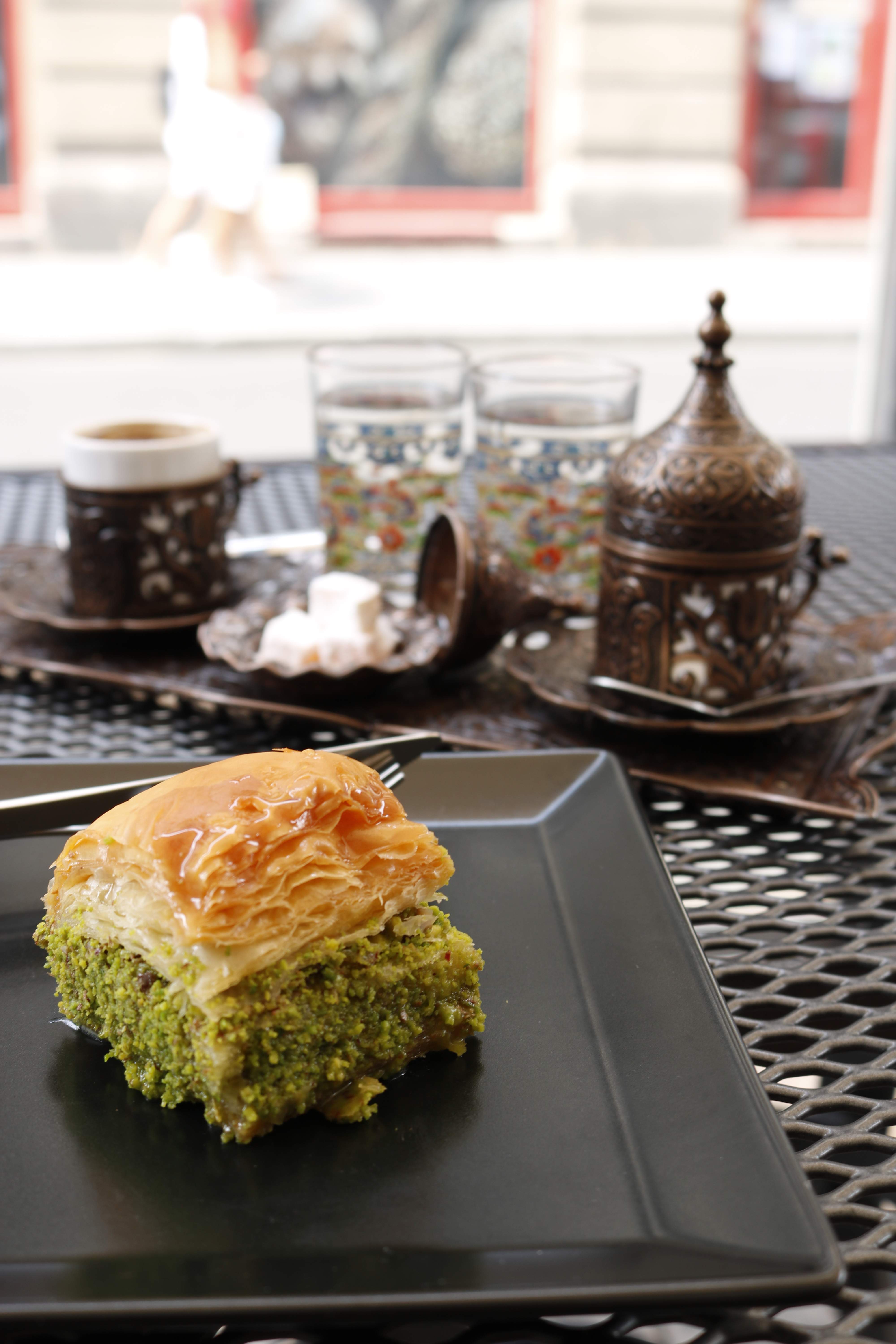
Baklava and Turkish coffee, served on the terrace at La Turka © Mateo Henec
We also have around 40 different kinds of Turkish Delight, halva (made from tahini, with different versions using cacao, chocolate). We sell the finest quality coffee available in Turkey. It’s quite unlike anything on sale here. We also have Turkish tea, which we present complimentary to anyone who comes to sit and try our food.
We want to offer an authentic taste of Istanbul. Everything from the interior design to the music we play helps us do this. We’re aiming to be a little like the Grand Bazaar. Except we don’t sell carpets, obviously. Ha!
You can visit La Turka at Petrinjska 47
You can read the introduction to our series on Zagreb international cuisine and the first installment here
To follow our whole series on international cuisine and to follow the Croatian restaurant and gastro scene, keep an eye on our Gourmet pages here
Dalmatian Restaurants Try To Survive Coronavirus Summer
May 26, 2020 — This was supposed to be a good year for foodies in Croatia. Michelin Stars, increased visibility, delivery apps, and ever-increasing tourism numbers fueled a gastronomic renaissance in Croatia. Hopes for a boom in 2020 remained high. Now, some restauranteurs and hospitality workers will hope to merely survive until next year.
Dalmatia’s chefs expect a catastrophic season. Not merely measured against the last few years, but overall. Between the coronavirus pandemic, costly epidemiological measures, the ensuing economic downturn, a late start to the summer season and general uncertainty, revenue at some eateries could plunge by 70 percent compared to last year. Some chefs told Slobodna Dalmacija they won’t even bother opening unless they know they’ll recoup costs.
Restaurants in far-flung locations like Lastovo may suffer the most. Already disconnected from the mainland, a late start to the nautical tourism season combined with limited ferry service is forcing eateries on islands all along the Adriatic to remain closed.
It’s a strange irony of the coronavirus era: many Croatian restaurants think closed is the best way to stay open. At least in the long term. Marčlino Simić owner of Lastovo’s “Porto Rosso” did the math himself and kept his kitchen shuttered.
“For now, I do not intend to open my business because it is only an expense for me if there are no nautical tourists,” he said. “I’ll see around June 15 if anything changes.” He’s not alone.
“More than 30 percent of Croatian caterers will not open the doors of their facilities,” chef Duje Pisac of Puteus Palace said. “I am also sure that in September a huge number of restaurants and cafes will change owners, go for rent or sell.”
The chef last year brought in cooks and waiters from Serbia; the local labor market couldn’t match his needs. He’d been planning to hold on to the staff for this year, expecting a profitable season.
Puteus Palace, a boutique luxury hotel on Brač, will open on June 15. Cancelations for now remain low but nevertheless both wages and orders have been cut to save cash.
“This is the only way we can make money,” Pisac said.
“We canceled everything because there is no work, and there was a surplus of domestic labor,” he added. “The hotel kitchen where I worked with eight people last year, this year it will fall on three people. And God forbid that I stay on that number until the end of the season.”
Chef Braco Sanjin of Split’s “Kadene” reoriented the menu towards domestic guests — a tectonic departure from its usual offerings. Prices were slashed while attempting to maintain a fine dining experience.
It’s a tightrope many higher-end restaurants are walking — reducing prices but not quality — to compete in an industry already used to razor-thin margins.
“These are all necessary adjustments we had to make to survive this summer,” Sanjin said.
Ivan Pažanin — perhaps one of Croatia’s most-recognizable chefs and television mainstay — is cutting prices by up to 20 percent at “Štorija” in Split. He’s called for lower highway tolls to incentivize travel within the country.
Still, many worry the time lost since the mid-March lockdown will be hard to make up.
“Two non-working months in the busiest part of the year for caterers means a collapse, which will drag on for the next five seasons,” Pisac said. “And the worst will be for the one who took out the loans, or for the one from the lease.”
Šimić has dim hopes for his Lastovo establishment but sees a silver lining for the country.
“We will be happy to earn 35 to 40 percent this year compared to last year,” he said. “The coronavirus brought us a historic chance to change something, for knowledge to pass from our asses into our heads about which way this beautiful country of ours should go.”
Croatian Restaurants Say Coronavirus Measures Jeopardize Business
April 24, 2020 — Croatian life began a slow march towards normalcy, with the announcement of incrementally-relaxed restrictions over the coming weeks. Restaurants and cafes claim the government's current plan will tank their business, hoping a return to normal comes sooner than expected.
Dalmatian restauranteurs said in interviews they will not have Plexiglas dividers in their establishments, nor will transparent barriers line their terraces this summer.
The Civil Protection Directorate's 11-point list of anti-coronavirus measures taking force on May 11 will increase costs, sink revenues and ruin guest's experiences, they argue, adding it's not even worth opening.
Most said they would prefer to keep their facilities closed until regulations soften, after which they would respond in two days by opening the facilities.
"Last year, at this time, we already had a lot of work and money," one caterer told Slobodna Dalmacija. "This year, we don't even make plans, everything stops."
The new measures would send operating costs skyrocketing, the source added. "A glass of water with coffee or lunch becomes too expensive for us. Because that glass of water now needs to be disinfected, sterilized. We're destroyed now."
Dalmatian chef Pero Savanović said the measures were unacceptable. In his tavern "Mediteran" in Primosten, guests usually sit packed tightly, with backs nearly touching.
"I cannot agree to the measures that are now set as the ultimatum," he said. "By adopting these XXXL measures, we are in a position of unprofitable business.
"At this time last year we were already working full steam," Savanović added. "This year we will wait until the last moment, hoping that someone above, from the decision-makers, will realize that we cannot work on the guest screening system."
A thinning crowd is just one problem. The added costs make the measures unmanageable. Savanović pegged the cost of plexiglass barriers for his terrace at HRK 100,000.
Still, many hope the coronavirus will subside, borders will reopen and tourists will come. Even in this scenario, Savanovic suggests the domestic guest may be key.
Even in the best-case scenario of all wealthy Croats dropping wads of kunas at every meal, Savanović said he'll have to cut staff. The price of labor will be reduced. Food and drink would be cheaper. And a new value system will be established in the catering market.
Savanovic said the measures are made by robots who are just waiting to have a chip installed. Restaurants do not serve a biological need for sustenance, but a social one. Plexiglass, Savanović said, makes this impossible.
"Even in the best conditions, only family restaurants will survive, and those with a quality offer," he said. "There will be order in the chaos, everything that was created for fast profits, poor quality, bad, will fall out of the game."
Well-known chef Duje Pisac said the coronavirus made an unholy mess. Even the luxury heritage hotel in Brac, which is filled by a deep-pocketed clientele has not opened its doors. If the measures are strict, they probably won't.
"How do you arrange breakfast under such conditions? It's hard," Pisac said. "How do you ensure physical distance at the pool? No way. Measures as they are now, and as announced, are deadly for us hospitality and hospitality workers."
He echoed Savanović's issues with the Plexiglass but also suggested wait staff dressed as surgeons won't help either. "Waiters' gloves? Yes, fine. But masks? I can accept them, but then it's not the same. It immediately alludes to danger, to distress."
Restaurant Horizont - When in Dubrovnik, Eat Like Locals Do
When it comes to traditional cuisine prepared with care in the very heart of Dubrovnik, Restaurant Horizont should be your first port of call.
Slavonski Brod Welcomes First McDonalds Restaurant
The 29th McDonalds restaurant in Croatia now calls Slavonski Brod home.
Where are the Best Sommeliers in Dalmatia? Dubrovnik!
On Thursday, May the 18th 2017, at the Hotel Park in Split, the premiere of the ''Sommelier of Dalmatia'' was held as part of a conference consisting of top wine-lovers and experts.
Konobas in Split: A List That Grows As Do Our Bellies
Please see below list of preferred konobas and eateries in Split where you can taste traditional Dalmatian and Croatian cuisines. Click read more to get an insider's scoop on each eatery. The list is ever increasing (as is the size of our stomach) as we personally pay these joints a visit to give you an honest insight into the eateries in Split.
Stare Grede

(Domovinskog rata 46; +385(0)21 485 501; Facebook Page)
Stare Grede means ‘old beams’ and this traditional tavern only 1km from the center is just that; old beams and rustic wooden benches. Meat is really Stare Grede’s forte with game often found on the menu. Stare Grede also stir up a sumptuous selection of daily dishes going from 29KN only...read more.
Konoba Hvaranin

(Ban Mladenova 9; +385(0)91 5477 946)
Konoba Hvaranin (meaning ‘man from Hvar’) is a miniscule eatery, popular with the city’s intellectualsthat, which dish up local fare from the freshest ingredients and have become particularly known for their Hvaranin clams and a tribute-to-grandma-like rožata, Dalmatia’s take on crème brûlée...read more.
Fife

(Trumbiceva obala 11; +385 (0)21 345 223)
We all seek authenticity, the best produce, and the most comfortable surroundings but sometimes a true local experience means spotty service, loud kitchen staff, crowded seating, and cheap wine; that’s Fife for you, a truly authentic and affordable Split institution...read more.
Villa Spiza

(Kružićeva 3; +385 (0)91 152 1249)
Hipsters and bohos swarm to this budget bistro for a soulful bite whisked together after a morning stroll through the marketplace. Adding to its charm, this no-frills downtown joint has an eclectic mix of cutlery and plates, bar-top seating, an open kitchen, and a random art selection on its walls…read more.
Grego Levante

(Bosanska 2; +385 (0)91 204 2222)
Named after the wind the blows from the Greek coast towards to Adriatic, this new little konoba is located within the western walls of Diocletian’s palace. At Grego Levante you will find traditional Dalmatian fare but in the mix are ancient dishes rarely found in restaurant but so loved by the Splićani (the people of Split)...read more.
Pimpinella

(Spinčićeva 2A; +385 (0)21 389606)
Don’t be fooled by the 1980’s interiors that take you back to a long lost era in Croatian history, Konoba Pimpinella dish out wholesome interpretations of traditional fare. Pimpinella is one of the most popular for the local crowd from all walks of life; from prime ministers to shopkeepers. Their prices are fair and the food hearty and don’t miss their lunch-time tuna pašticada on Fridays... read more.
Konoba Kod Joze

(Sredmanuška 4; +385 (021) 347397)
Locals and tourists alike swarm to this hideaway to flavour traditional Dalmatian fare on the intimate terrace in the summer or indoors under fish netted ceilings during wintertime. Try the signature dish, "green tagliatelle with assorted shellfish" which has been mentioned in several tourist publications; this is a pasta concoction of Adriatic delicacies... read more
Oštarija u Viđakovi
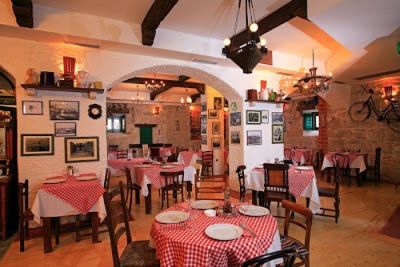
(Prilaz braće Kaliterna 8 ; +385 (0)21 489 106; www.ostarijavidjakovi.com)
Oštarija u Viđakovi is a konoba hidden down a tight street in the Bačvice neighborhood with an intimate terrace and eclectic interiors. Oštarija u Viđakovi was founded in 1799 and the menu is strictly Dalmatian with traditional dishes, grandma’s recipes and seafood fare... read more.
Šperun
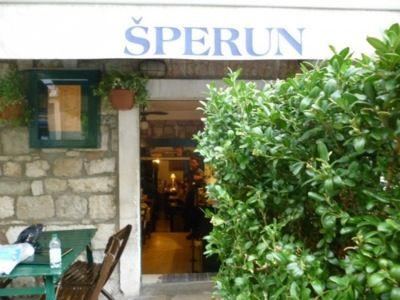
(Šperun 3; +385 (0)21 346 999)
A traditional konoba (tavern), Šperun is a little eatery up the road next to the St. Francis church near Riva. The interiors are so welcoming, boasting a country feel with rustic interiors, exposed walls, old tins and radios, checkered tablecloths and waiters in sailor uniforms. The menu of course includes all the Dalmatian specialties under the sun, domaći (home-made) and fine local wines... read more.
Gradska Kavana

(Narodni Trg 1 (Pjaca); +385(0)21 317 835)
All major Croatian cities are marked with a Gradska Kavana (City Tavern) of some sort. Split’s Gradska Kavana is located on the popular Pjaca Square, and although the renovated interiors still bring you back to socialist Croatia, they serve some hearty value-for-money dishes...read more.
Trattoria Tinel

(Tomica Stine 1; +385 (0)95 829 2005)
Tinel (meaning living room in Dalmatian dialect) looks so warm and inviting through the windows. With dimmed lighting and an interior that merges lush velvets, country details and shabby chic with eclectic seating and high exposed walls, this Trattoria really looks like a living room. The menu mirrors most local konobas with a variety of traditional fare such as pasta, fish and meats, and the obligatory pancake selection however; there are a few ´originals’ in the mix...read more


